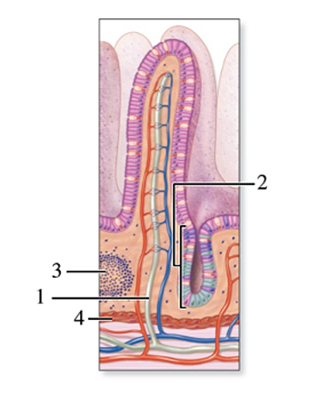A) the transport of bile and pancreatic juice.
B) the secretion of mucus.
C) the passage of chyme into the small intestine.
D) peristalsis.
E) salivary gland secretion.
Correct Answer

verified
Correct Answer
verified
Multiple Choice
Which organ is not part of the gastrointestinal tract?
A) Esophagus
B) Large intestine
C) Stomach
D) Oral cavity
E) Liver
Correct Answer

verified
Correct Answer
verified
Multiple Choice
Which region of the digestive tract moves material by peristalsis,haustral churning,and mass movement?
A) Large intestine
B) Small intestine
C) Stomach
D) Esophagus
E) Pharynx
Correct Answer

verified
Correct Answer
verified
Multiple Choice
What structures comprise a portal triad?
A) Branches of the hepatic artery,hepatic vein,and hepatic duct
B) Branches of the common bile duct,central vein,and hepatic artery
C) Branches of the hepatic duct,cystic duct,and central vein
D) Branches of the hepatic artery,hepatic portal vein,and hepatic duct
E) Branches of the cystic duct,central vein,and hepatic artery
Correct Answer

verified
Correct Answer
verified
Multiple Choice
The liver parenchyma,gallbladder,pancreas,and biliary apparatus develop from the endoderm of the
A) duodenum.
B) hepatic crest.
C) transverse colon.
D) lesser omentum.
E) umbilical cord.
Correct Answer

verified
Correct Answer
verified
Multiple Choice
The term "canines" describes the teeth that
A) are most anterior,used for slicing and cutting.
B) are lateral to the incisors,used for puncturing and tearing.
C) bear dental cusps for cutting and grinding.
D) are only found as permanent teeth.
E) are only found in dogs.
Correct Answer

verified
Correct Answer
verified
Multiple Choice
Which peritoneal fold attaches the liver to the anterior internal body wall?
A) Coronary ligament
B) Falciform ligament
C) Mesentery proper
D) Intraperitoneal ligament
E) Hepatic ligament
Correct Answer

verified
Correct Answer
verified
Multiple Choice
Why are there so many phagocytic cells (in lymph nodes and the liver,for example) associated with the digestive system?
A) They stimulate digestive enzyme production.
B) They remove bacteria and other foreign material ingested with food.
C) They stimulate contractions of the tunica muscularis.
D) They stimulate proliferation of stem cells.
E) They can transform into other cell types under the appropriate hormonal stimulation.
Correct Answer

verified
Correct Answer
verified
True/False
The quadrate lobe is visible on the inferior surface of the liver,adjacent to the gallbladder.
Correct Answer

verified
Correct Answer
verified
True/False
The greater and lesser curvatures of the stomach form during development as a result of differential growth rates between the anterior and posterior surfaces.
Correct Answer

verified
Correct Answer
verified
Multiple Choice
Which is not correct regarding saliva?
A) Its pH is slightly alkaline.
B) Daily production is 1-1½ liters.
C) It contains antibodies and an antibacterial enzyme.
D) The majority of its volume is water.
E) It contains mucus to aid in swallowing.
Correct Answer

verified
Correct Answer
verified
Multiple Choice
The central cavity of a tooth is filled with
A) cementum.
B) dentin.
C) pulp.
D) enamel.
E) calcium phosphate.
Correct Answer

verified
Correct Answer
verified
Multiple Choice
What is the primary function of the large intestine?
A) Storage of vitamins and minerals
B) Protein digestion and nutrient absorption
C) Water and electrolyte absorption
D) Secretion of water,salts,sodium bicarbonate,and enzymes
E) None of the choices is correct.
Correct Answer

verified
Correct Answer
verified
Multiple Choice
Which is not correct regarding teeth?
A) The primary component of teeth is dentin.
B) The outer surface of enamel forms the crown of a tooth.
C) The central portion of a tooth is the sinus cavity.
D) The root is covered by cementum.
E) The apical foramen is the opening at the tip of the root.
Correct Answer

verified
Correct Answer
verified
Short Answer
A lymphatic capillary within a villus of the small intestine is called a ____________.
Correct Answer

verified
Correct Answer
verified
Multiple Choice
Late one night,while studying for your anatomy class,you open a box of saltine crackers to do a little snacking.After chewing on a starchy morsel for a few minutes,you begin to notice a sweet taste in your mouth.What accounts for this?
A) "Sweet" taste receptors are slower to respond than others.
B) Activity of bacteria in the mouth lowers the pH.
C) Esophageal reflux
D) Salivary amylase activity
E) Phagocytosis by the pharyngeal tonsils produces by-products that taste sweet.
Correct Answer

verified
Correct Answer
verified
Multiple Choice
 -This figure shows an intestinal villus.What is the invagination indicated by number 2?
-This figure shows an intestinal villus.What is the invagination indicated by number 2?
A) Gastric gland
B) Lymphatic nodule
C) Intestinal gland
D) Endocrine gland
E) Peyer patch
Correct Answer

verified
Correct Answer
verified
Short Answer
The process of swallowing is also called _____________.
Correct Answer

verified
Correct Answer
verified
Multiple Choice
The inferior esophageal sphincter is also known as the
A) cardiac sphincter.
B) pyloric sphincter.
C) pharyngoesophageal sphincter.
D) pharyngealgastric sphincter.
E) esophageal hiatus.
Correct Answer

verified
Correct Answer
verified
True/False
Of the three phases of swallowing,only the esophageal phase is involuntary.
Correct Answer

verified
Correct Answer
verified
Showing 81 - 100 of 103
Related Exams